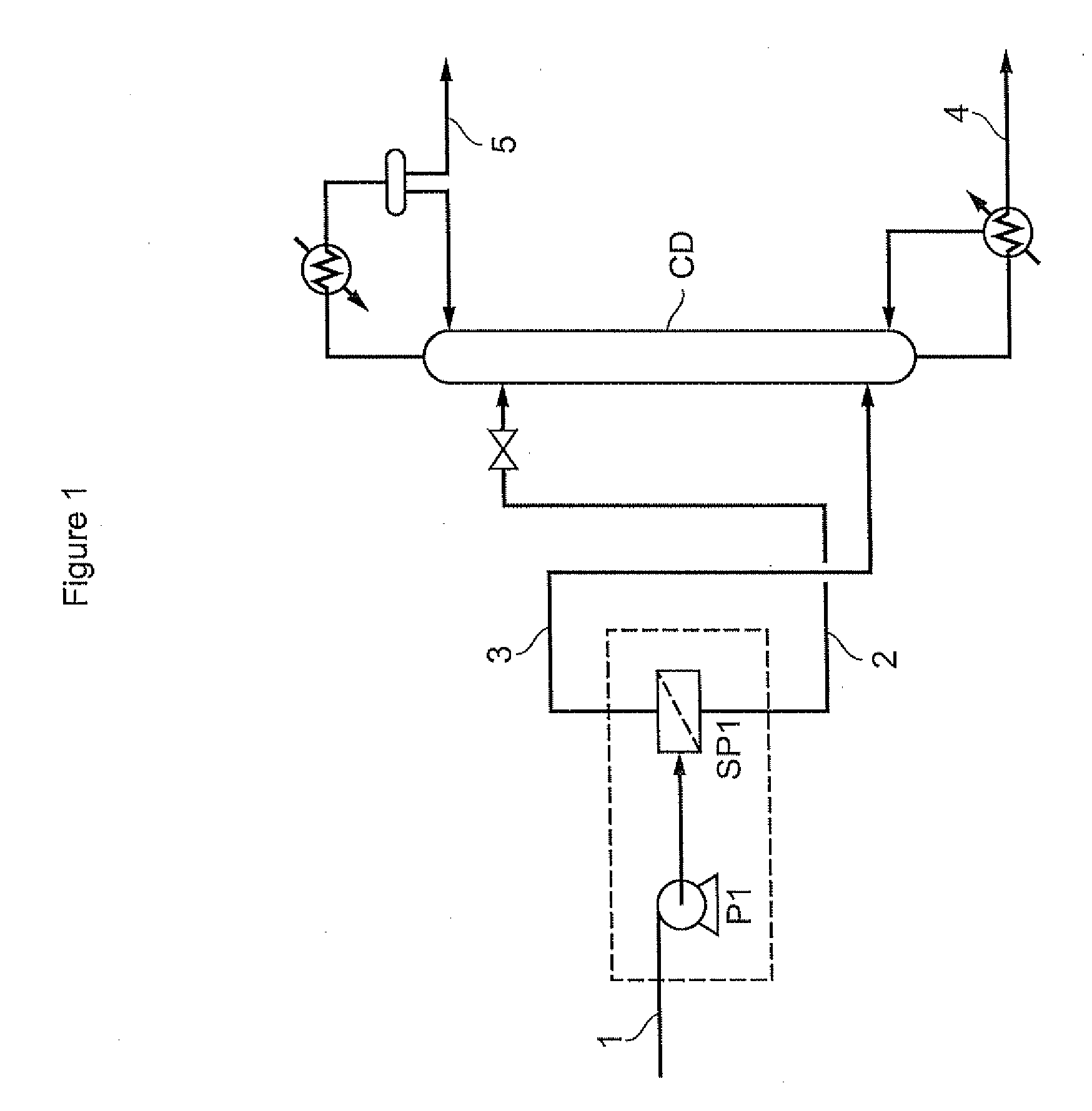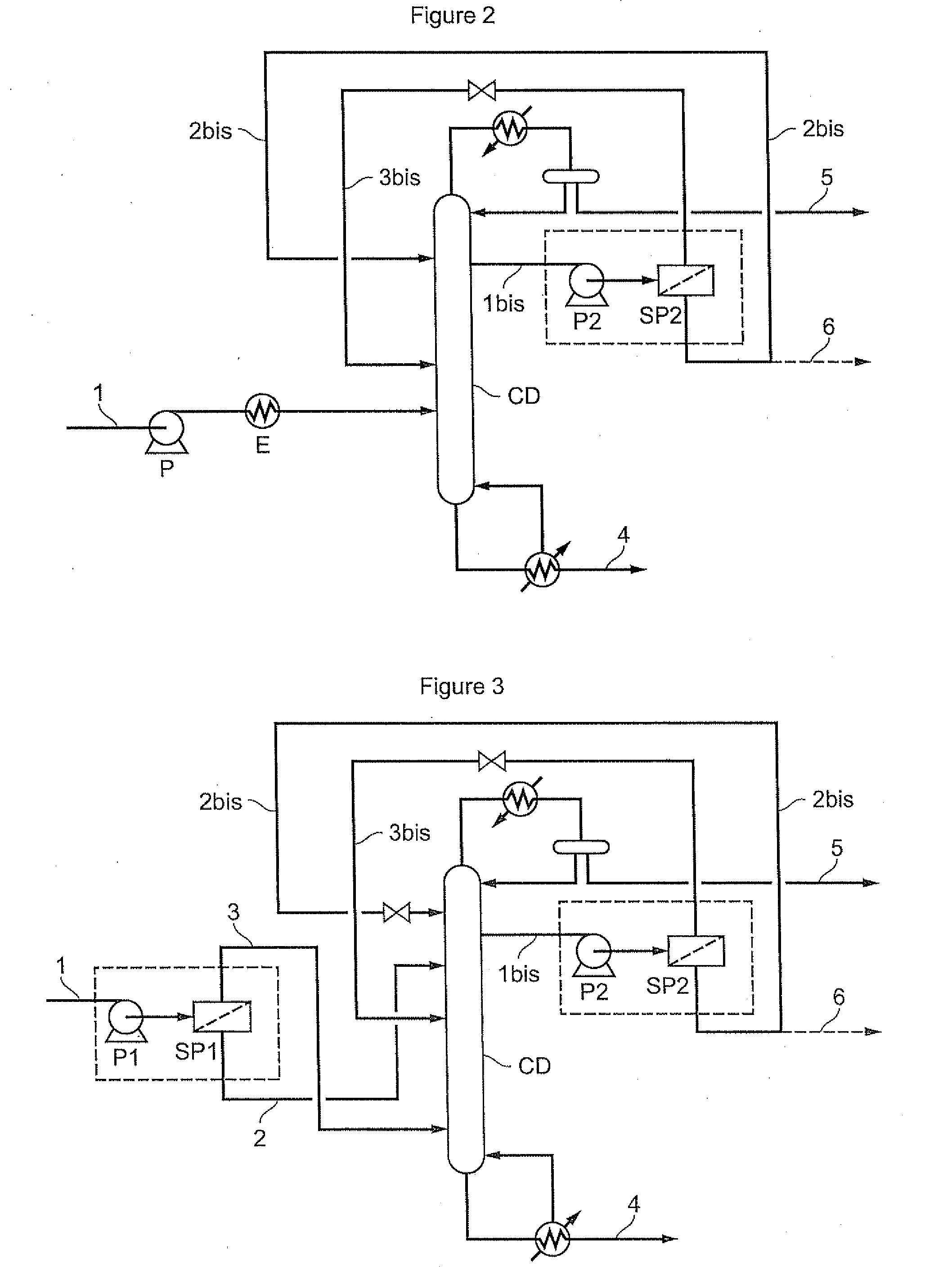Process for separating propane and propylene using a distillation column and a membrane separation column
a technology of distillation column and separation column, which is applied in the separation of solid sorbent liquid, isotope separation, water/sludge/sewage treatment, etc., can solve the problems of high recompression cost, high investment cost, and fragile carbon-type membran
- Summary
- Abstract
- Description
- Claims
- Application Information
AI Technical Summary
Benefits of technology
Problems solved by technology
Method used
Image
Examples
examples
[0106]The following three examples illustrate the benefit of the invention in terms of economic profitability and increase in production capacity.
[0107]The first 2 examples are in the form of a comparison between 3 systems according to the invention (denoted “upstream” case / “downstream” case / “upstream+downstream” case) and a base case corresponding to the prior art and having only one distillation column (with no membrane separation unit). The third example according to the invention compares the pervaporation and supercritical operating conditions.
[0108]In all the examples according to the invention, a polymer membrane is used with permeability equal to 10 barrer and propane / propylene selectivity equal to 10.
example no.1
Example No. 1
Comparison of the Performances of the Process According to the Invention / Prior Art Under “Prevaporation Conditions”
[0109]This example makes it possible to evaluate the saving that can be made by integrating the membrane separation units with the propane / propylene distillation column with a view to treating the same feedstock capacity.
Base Case (Prior Art)
[0110]The base case consists of a separation of a propane / propylene feedstock carried out by means of a distillation column comprising 170 plates and operating with a reflux rate of 13.
TABLE 1Characteristics of the propane / propylenedistillation column used for the base caseTemperature at top49.1° C.Temperature at base65.8° C.Pressure at top20.5 barTheoretical plates168 + condenser & reboilerFeedliquid at plate 121Draw-off at top99.5% by mass of propyleneDraw-off at base 5% by mass of propyleneΔP0.01 bar / plate
[0111]The main operating cost of the distillation column is to be found in the heat to be supplied to the reboil...
example no.2
Example No. 2
Illustrating the Increase in the Capacity of the Distillation Column Under “Pervaporation Conditions”
[0139]The process according to the invention makes it possible to increase the treatment capacity of the installed distillation column.
[0140]Simulations carried out on the commercial software (PROII) have made it possible to define the new flooding limits of the distillation column in the process according to the invention and thus to reach the maximum treatment capacity of the process according to the invention. The calculations showed a treatment capacity up to 37% greater than the reference case for the “upstream+downstream” case.
[0141]The process according to the invention in the “upstream+downstream” case is of particularly great benefit within the framework of a debottlenecking of the gas plant.
[0142]The reduction in the manufacturing cost for this configuration is assessed at up to 17% compared with the reference case, as shown by Table 10 below.
TABLE 10Evaluation...
PUM
| Property | Measurement | Unit |
|---|---|---|
| pressure | aaaaa | aaaaa |
| temperature | aaaaa | aaaaa |
| temperature | aaaaa | aaaaa |
Abstract
Description
Claims
Application Information
 Login to View More
Login to View More - R&D
- Intellectual Property
- Life Sciences
- Materials
- Tech Scout
- Unparalleled Data Quality
- Higher Quality Content
- 60% Fewer Hallucinations
Browse by: Latest US Patents, China's latest patents, Technical Efficacy Thesaurus, Application Domain, Technology Topic, Popular Technical Reports.
© 2025 PatSnap. All rights reserved.Legal|Privacy policy|Modern Slavery Act Transparency Statement|Sitemap|About US| Contact US: help@patsnap.com



